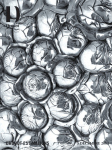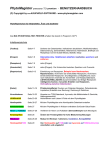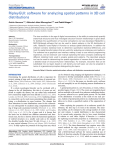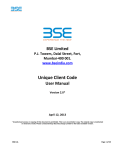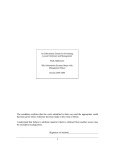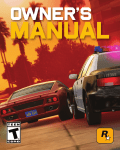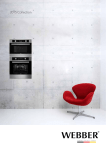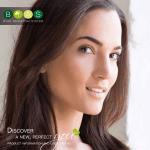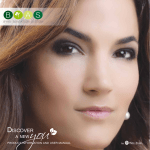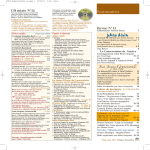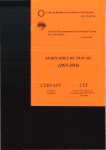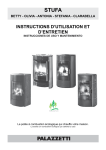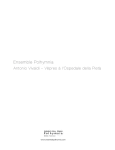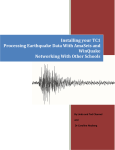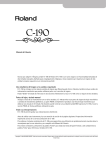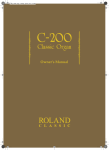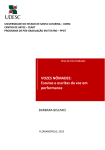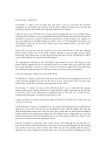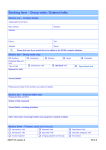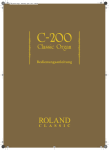Download November - York & District Organists` Association
Transcript
YDOA PipeLine November 2015 November 2015 The PipeLine YDOA Journal Patron President Vice President: Secretary Treasurer Membership Secretary PipeLine Editor Francis Jackson Joan Johnson Maximillian Elliott Renate Sangwine Cynthia Wood Helen Roberts Stephanie Holdsworth 01388 607710 07956 525488 01904 781387 01904 795204 01904 708625 01904 640520 [email protected] [email protected] [email protected] [email protected] [email protected] [email protected] www.ydoa.co.uk The York & District Organists' Association is affiliated to the Incorporated Association of Organists (IAO) and serves all who are interested in the organ and its music. -1- November 2015 YDOA PipeLine YDOA Presidents – Past and Present Founded in 1945 1977-8 Ruth Smith 1945-6 Edward Cuthbert Bairstow 1978-9 Maureen Murfitt-Swindells 1946-7 Reginald Shepherd Rose 1979-80 Geoffrey Hunter 1947-8 Archie W Sargent 1948-9 Francis Alan Jackson 1980-1 Robert Hall 1949-50 H Reginald Mason 1981-2 Michael Latham 1950s 1982-3 Richard Crosby 1950-1 Frederick Waine 1983-4 Peter Maw 1951-2 Reginald Shepherd Rose 1984-5 Eric Grewer 1952-3 Edmund Stanley Walton 1985-7 David Templeman 1953-4 Benjamin Dawson 1987-8 Lloyd D Smith 1954-5 Benjamin Summerton 1988-9 Geoffrey Coffin 1955-6 W Allen Bean 1989-91 George Piling 1956-7 George James Stacey 1957-8 Joseph Samuel McElheran 1991-3 Douglas Heath 1958-9 Walter Hartley 1993-4 Nicholas Page 1959-60 Benjamin Dawson 1994-5 David Simpson 1960s 1995-6 Alan Aspinal 1960-1 Bernard J Porter 1996-7 Peter Whitehead 1961-2 Ronald Perrin 1997-8 Maureen Murfitt-Swindells 1962-3 William Addamson 1998-9 Jean Pilling 1963-4 Alec C Cooper 1999-2000 Edmund Cooke 1964-5 Evelyne G Bowmer 1965-6 George L Baggaley 2000-1 Alfred Boddison 1966-7 Tom Ward 2001-2 Cynthia Wood 1967-8 Alec Brodie 2002-3 Edmund Cooke 1968-9 Michael Minns 2003-4 David Simpson 1969-70 Avena Helen Norfor 2004-5 Philip Paul 1970s 2005-7 Phillip Sangwine 1970-1 Lloyd D Smith 2007-9 Andrew Roberts 1971-2 Colin McGarritty 2009-2011 Adrian Crawford 1972-3 Michael Phipps 1973-4 Jack Judson 2011-13 Raymond Sturdy 1974-5 Alfred Alcock 2013-15 Nigel Holdsworth 1975-6 A Austin Winterbottom 2015-present Joan Johnson 1976-7 Peter Whitehead 1980s 1990s 2000s 2010s -2- YDOA PipeLine November 2015 Welcome to the November Edition! Hello to all YDOA members! May I introduce myself? I am Stephanie Holdsworth, wife of Nigel Holdsworth and I will be your PipeLine editor for a year. Even though I am not an organist I hope to be able to present you with interesting articles and contributions – but I will also be dependent on your own contributions to keep your monthly newsletter/magazine relevant to you! Hence I am looking forward to hearing from you with suggestions of articles and contributions of your own – and nothing is too small, insignificant or unusual. So, what am I looking for from you? I have introduced the “Members' Pinboard” which really is YOUR area. You can • post a question, • send in a joke (as long as it is seemly enough), • share a story of an event or an encounter, • tell us something about yourself, • introduce a piece you are playing at the moment, • be the subject of a feature/portrait of yourself and where you play, • post a funny or interesting picture or • share anything else which might be of interest to YDOA members. I am happy to help write anything up, visit you (within reason, of course!) for an interview or take photos. I think it is important that you are not afraid to come forward so that your magazine firmly remains YOUR magazine! I can best be contacted via email on [email protected] or by phone at home on 01904 640520 which has an answerphone should I not be in. I am looking forward to hearing from you! In the November Edition YDOA Events..................................................................................................4 Upcoming Recitals & Concerts..............................................................6 Peter Collins – Organ Builder...............................................................11 Members' Pinboard..................................................................................12 Bruhns in “Brum” by John Jones........................................................14 Out and About – Crambe......................................................................16 Clifford Organ Restored and Celebrated!.......................................18 Auntie Ada's Armchair............................................................................21 Competition Time and Give-Away!!!.................................................23 Photography for Organ Lovers............................................................24 Crossword....................................................................................................28 -3- November 2015 YDOA PipeLine YDOA Events The AGM The AGM 2015 took place in Central Methodist Church Hall on Saturday, 24th October 2015 at 11:30 followed by a “Bring & Share Lunch” which in turn was followed by Paul Hale's richly illustrated slide lecture on English Painted Organ Pipes. Good Attendance at the AGM There was a very good turn-out of about 30 YDOA members which, at a membership of 81 makes over 1/3 attendance. The AGM moved through its agenda very smoothly. All points were approved and voted on. A full AGM report and a transcript of Nigel's speech will be published in next month's PipeLine. Joan receives the Presidential Medal The new committee was proposed, accepted and voted in: President: Vice-President: Secretary: Membership Secretary: Treasurer: Joan Johnson Maximillian Elliott Renate Sangwine Helen Roberts Cynthia Wood Committee Members: Nigel Holdsworth, Philip Paul, John Ridgeway-Wood, Phillip Sangwine and Robert Sharpe. The lecture in Central Methodist Chapel Plenty of food was brought and shared during lunch while tea was served by both the ex-President as well as the new President of the YDOA! Paul Hale's lecture Paul Hale was held in Central During the Lunch, tea was served by Methodist Chapel and was richly illustrated by a slide both ex- and new YDOA Presidents! show in two parts with a tea break in between. He presented an overview of English Painted Organ Pipes from the Middle Ages to the Present. -4- YDOA PipeLine November 2015 Upcoming Event: The next YDOA event is a lecture-recital taking place on Saturday, 28th November at Central Methodist Church Hall at 14:00 The Clarabella Duo are Entertaining Mark Wharfedale (Baritone) Maximillian Elliott (Piano) A Trio of York Composers The Clarabella Duo were founded in 2013 by Mark Wharfedale (Baritone) and Maximillian Elliott (Piano and Organ). Over the past two years, the duo has explored a wide variety of repertoire and has developed a reputation for performing light-hearted music by local composers. Two recordings of the duo were made by Stephanie Holdsworth at a concert on the 14th of December 2013 in St Mary's Church, Boston Spa and these are available via YouTube, or via the Clarabella Duo page on Maximillian Elliott's website: http://tubamagna.wix.com/maximillianelli ott#!clarabella-ensemble/c85w. The concert will feature vocal and piano music from three local musicians: Thomas William Hanforth (1867-1948) Arthur Sample (1861-1940) and Robert Werner Oberhoffer (1854-1916). All three composers were based in York at about the same time towards the end of the nineteenth century. Their music is wonderfully melodious and should appeal to almost all palettes. In addition to the music, some brief biographical information will be given about each composer, in an attempt to lift them out of their unjust obscurity! The Clarabella Duo at a concert in Boston Spa in 2013 -5- November 2015 YDOA PipeLine Upcoming Recitals & Concerts All concerts are listed in date order! While all care has been taken for the accuracy of this information, this list will only represent a selection of events in this area. Please note that no guarantee can be given for the accuracy of this information. If in doubt, please check at the venue. If you are missing a location or event you wish to see published in the PipeLine, please contact me. Date & Time Location & Church Organist Further Information Mon, 02/11/2015 13:00 Huddersfield Town Hall Gordon Stewart (Kirklees Borough Organist) George King, Piano admission £5 Mon, 02/11/2015 13:05 Leeds Town Hall Simon Lindley (Leeds Minster) Phillip McCann, Cornet admission free Wed, 04/11/2015 12:30 Hull City Hall Philip Rushforth (Chester Cathedral) Organ Showcase admission £3.50 Wed, 04/11/2015 13:00 Bradford Cathedral Alexander Woodrow (Bradford Cathedral) admission free Thu, 05/11/2015 11:00 Fulneck Moravian Church Simon Lindley (Leeds Minster) admission free Thu, 05/11/2015 13:00 Halifax Minster Geoffrey & Christopher Brown admission free Fri, 06/11/2015 12:30 Leeds Minster David Houlder (Leeds Minster) Fri, 06/11/2015 12:30 Ilkley Graham Toft St Margaret's Church (Settle Parish Church) admission free Fri, 06/11/2015 13:00 Pontefract St Giles' Church Andrew Bryden (Ripon Cathedral) admission £3 Sun, 08/11/2015 14:30 Saltaire Victoria Hall Robert Wolfe (Concert Organist) Remembrance Sunday admission £9/ COS members £8 Mon, 09/11/2015 13:05 Leeds Town Hall Anthony Norcliffe (Mill Hill Chapel, Leeds) Music for the Time of Remembrance; admission free Tue, 10/11/2015 13:00 Leeds Mill Hill Chapel Anthony Norcliffe (Mill Hill Chapel, Leeds) admission free Wed, 11/11/2015 13:00 Bradford Cathedral Colin Andrews (Indiana University, USA) admission free -6- admission free YDOA PipeLine November 2015 Date & Time Location & Church Organist Further Information Fri, 13/11/2015 12:30 Leeds Minster David Houlder (Leeds Minster) admission free Fri, 13/11/2015 13:00 Pontefract, St Giles' Church Paul Dewhurst (St Giles', Pontefract) admission £3 Sat, 14/11/2015 19:30 Elland Andrew Jacobs admission free Southgate Methodist (Southgate Methodist Church) Church Mon, 16/11/2015 13:00 Huddersfield Town Hall Daniel Cook (Westminster Abbey) admission £5/ concession £.50 Mon, 16/11/2015 13:05 Leeds Town Hall Simon Lindley (Leeds Minster) Claire Strafford, Soprano admission free Wed, 18/11/2015 13:00 Bradford Cathedral Katherine Dienes-Williams (Guildford Cathedral) admission free Wed, 18/11/2015 13:15 Huddersfield Uni St Paul's Hall Alexander Woodrow (Bradford Cathedral) admission free Thu, 19/11/2015 13:15 Ripon Cathedral Marilyn Harper (Christ's Chapel, Dulwich) Norman Harper (St George's Cathedral, Southwark) Organ Duets admission free Thu, 19/11/2015 20:00 Sheffield St Mark's, Broomhill Andrew Jacobs admission free Southgate Meth. Church, Elland Fri, 20/11/2015 12:30 Leeds Minster Anthony Gritten (Royal Academy of Music) admission free Fri, 20/11/2015 13:00 Pontefract St Giles' Church Christopher Newton (St Bartholomew's, Armley, Leeds) admission £3 Mon, 23/11/2015 13:05 Leeds Town Hall Simon Lindley admission free (Leeds Minster) Christopher Trenholme, Tenor Mon, 23/11/2015 20:00 Ranmoor St John's Church Julian Gunn Sheffield admission free Wed, 25/11/2015 13:00 Bradford Cathedral Jonathan Eyre (Bradford Cathedral) admission free Fri, 25/11/2015 12:30 Leeds Minster David Houlder (Leeds Minster) admission free Fri, 27/11/2015 13:00 Pontefract St Giles' Church Tim Campain (Warwick Road URC) admission £3 -7- November 2015 YDOA PipeLine Date & Time Location & Church Organist Further Information Fri, 27/11/2105 19:30 Harrogate St Wilfrid's Dick Sanderman (Rijssen, The Netherlands) admission £10 Fri, 27/11/2015 20:00 Sheffield St Mark's, Broomhill Jonathan Eyre (Bradford Cathedral) admission free Fri, 27/11/2015 13:10 Doncaster Minster Keith Hearnshaw (Concert Organist) admission free Mon, 30/11/2015 13:00 Huddersfield Town Hall Gordon Stewart (Kirklees Borough Organist) admission £5 Mon, 30/11/2015 13:05 Leeds Town Hall Simon Lindley (Leeds Minster) admission free Wed, 02/12/2015 12:30 Hull City Hall Roger Fisher Organ Showcase (Organist Emeritus, Chester admission £3.50 Cathedral) Wed, 02/12/2015 13:00 Bradford Cathedral Jon Payne (Poole, Dorset) admission free Thu, 03/12/2015 11:00 Fulneck Moravian Church Simon Lindley (Leeds Minster) admission free Fri, 04/12/2015 12:30 Ilkley Christopher Rathbone St Margaret's Church (St Margaret's, Ilkley) admission free Mon, 07/12/2015 13:05 Leeds Town Hall David Houlder (Leeds Minster) admission free Wed, 09/12/;2015 Bradford 13:00 Cathedral Alexander Woodrow & Jonathan Eyre (Bradford Cathedral) admission free Fri, 11/12/2015 13:00 Pontefract, St Giles' Church Jonathan Eyre (Bradford Cathedral) admission £3 Sun, 13/12/2015 14:30 Saltaire Victoria Hall Nicholas Martin (Concert Organist) admission £9 Mon, 14/12/2015 13:00 Huddersfield Town Hall Nigel Ogden (BBC Radio 2's “The Organist Entertains”) admission £5 Mon, 14/12/2015 13:05 Leeds Town Hall Simon Lindley (Leeds Minster) Choirs of Leeds Cathedral and Leeds Minster admission free Tue, 15/12/2015 13:00 Leeds Mill Hill Chapel Anthony Norcliffe (Mill Hill Chapel) Christmas Organ Music -8- YDOA PipeLine November 2015 Date & Time Location & Church Organist Further Information Tue, 15/12/2015 13:05 Leeds Town Hall Simon Lindley] (Leeds Minster) The University of Huddersfield Brass Band Seasonal Music Audience Carols admission free Thu, 17/12/2015 20:00 Sheffield St Mark's, Broomhill Andrew Linn (St Mark's, Broomhill) admission free Fri, 18/12/2015 13:00 Pontefract St Giles' Church Paul Dewhurst (St Giles', Pontefract) Includes Audience Carols admission £3 Mon, 21/12/2015 13:00 Huddersfield Town Hall Gordon Stewart (Kirklees Borough Organist) Huddersfield Boys' and Girls' Choirs and Adam Finchett, Percussion admission £5 Solemn Requiem Mass (Extraordinary Form) at The York Oratory (St Wilfrid's Church) Fauré Requiem (new edition by David Hill) sung by Choral Scolars of St Wilfrid's and St Helen's Organist: Robert Smith (Assistant Organist, York Oratory) Director: John Ridgeway-Wood (Organist, York Oratory) -9- including November 2015 YDOA PipeLine Are you organising an organ event? Why not publish it in the PipeLine? Just contact me: [email protected] - 10 - YDOA PipeLine November 2015 Peter Collins – Organ Builder by YDOA Member John Jones The British organ builder Peter Collins died on 24 th October after a short illness. Following apprenticeships with Bishop in England and Rieger in Austria, Peter Collins established his own organ building business in Redbourn, Hertfordshire in 1964 and became one of our most prolific builders of new organs with tracker action. Important examples of his work can be found at St Peter Mancroft in Norwich and also the Silberman-inspired organ, built for the St Albans St Peter Mancroft, Norwich International Organ Festival. As the company expanded it moved to new premises in Melton Mowbray in 1989. Always a pioneer, Collins joined forces with Allen Organs to produce a hybrid pipe-digital organ for Trono Church in Sweeden, which was followed by five more such instruments. Local examples of organs by Peter Collins St Peter Mancroft, Norwich can be found at the NCEM in York and St Benedict’s Church, Garforth. This year the British organ world has also seen the loss other builders who established themselves in the late 1960s including Martin Goetze (Goetze & Gwynn Ltd) and William Drake (William Drake Ltd), in addition to the much admired organist, John Scott. 1984 Organ, part of the EOS Collection - 11 - St Peter, Berkhamsted November 2015 YDOA PipeLine Members' Pinboard This is YOUR AREA where you can share your jokes, interesting stories, snippets from here or there, ask questions, get in There is an old saying that fugues touch with others, etc. All contributions are welcome, no are the type of music in which contribution too small! the voices come in one by one • Have you got a good joke to while the audience goes out one share? by one, but there is no statistical • Would you like to be “Member evidence to support this; of the Month”? • audiences have been known to Do you have a question for other members? leave in droves. • Are you looking for something where other members can help? • What are you playing now? What's on desk? Would you like to tell us about it? • Would you like to introduce your instrument and/or your parish to the membership? • Would you like to share an interesting story, an account of an interesting event, a memorable encounter or feature a favourite instrument? • Have you got a good picture for the Caption Competition? I'd love to hear from you. Contact me on [email protected]. PipeLine Buddies Wanted! As you know, the YDOA had to make the decision to issue the PipeLine as an electronic document – especially as it has grown almost to the format of a glossy magazine and in the times of increasing membership and very high postage rates! At the same time there are a few fellow members who, for one reason or another, do not have access to computers or the internet. Would you be able to be a “buddy” to such a member, for example by sharing your printouts with these members, perhaps coming to an arrangement for printing out a copy or sharing the information some other way? - 12 - your book YDOA PipeLine November 2015 Member of the Month: Malcolm Smart In three short sentences introduce yourself I'm from Doncaster when it was still the West Riding. In 1976 my sister said about my day job: “You're fed up with your job, aren't you? Write to that music shop in Sheffield and that music shop in York when you go to the Minster.” And I was there for 37 years. What sparked your interest in organs? My musical life started when I was 8 in St James' church choir with John King in Doncaster. My music teacher at high school was Christopher Wren. I also used to go to concerts in Sheffield City Hall. Then I progressed to Doncaster Choral Society. And then I was invited to join a choir run by William Appleby. He knew someone at Ely Cathedral and Mr Appleby used to take his choir to Ely to sing the services for a week in the summer. After that I went up to another church in Doncaster, St Aiden's in Wheatley Hills. Do you play the organ yourself? And if so, when/how did you start to learn? No, I don't play the organ. I am a keen supporter, enthusiast and a lover of organ and church music and the organ world. What is your favourite piece of music? I think it has to be Healey Willan: Introduction, Passacaglia and Fugue played by Francis Jackson at the Minster in “The Great Cathedral Organ Series”. When did you join the YDOA? It must have been 5 or 6 years ago when Philip Paul came into the shop and I was serving him. He said to me: “Have you ever thought about belonging to the York Organists' Association?” I said “Philip, I don't play.” And he said “You don't have to play to be a member!” What is your favourite local instrument? The obvious answer is “The Minster”. What is your favourite local (organ) event? The YDOA dinner. What do you like best about the YDOA? The visits, really; visiting organs. What would you like the YDOA to do which it currently does not? As an association, to join with other associations and a foreign tour. What is the most exciting thing you have done/ experienced? When I was with the Doncaster choir visiting Ely Cathedral we had just finished Evensong. All of a sudden Francis Jackson's Fanfare to John Bradley was played. - 13 - November 2015 YDOA PipeLine Bruhns in “Brum” by John Jones To celebrate the 350th anniversary of the birth of Nicolaus Bruhns (1665-1697), the IAO, RCO and BIOS organised a celebration day at the Elgar Concert Hall, University of Birmingham on Saturday 19th September. The Elgar Concert Hall might be expected to contain a copy of a late nineteenth century Hill or Nicholson & Co organ, but it contains two recently completed organs by the highly regarded French Builder Marc Garnier. The splendid looking North German style case contains a three manual instrument based on South German tonality. The sounds reminded me very much of Altenburg with warm singing principals and beautiful flutes and reeds, all of which blended superbly with no hint of harshness or chiff. Hauptwerk Bourdon Trompete Prästant Gedeckt Octav Spitzpfeife Quint Superoctav Cornet Mixtur Trompete 16' 16' 8' 8' 4' 4' 3' 2' 5f. 1 1/3 8'2 Kleinwerk Portunal Quinadena Principal Flöte Nasat Octav Terz Quintlein Dulcian 8' 8' 4' 4' 3' 2' 1 3/5' 1 1/2' 8' Schwellwerk Stillflöte 8' Gamba 8' Fugara 4' Sesquialter 2f. Flageolet 2' Trompete 8' Oboe 8' Vox Humana 8' Pedalwerk Subbaß Prästant Gedacktbaß Octav Mixtur Posaune Trompete 16' 8' 8' 4' 2' 16' '8 Follow-Ups for You: Accessories: Hw/Pw Kw/Pw Sw/Pw Kw/Hw Sw/Hw Sw/Kw Tremulant: Hw – Kw – Sw – Pw Zimbelstern 6f Vogelgesang Mitteltönigeswerk Gedackt 8' Portunal 4' Kleinflöte 2' Nicolaus Bruhns Quintlein 1 1/2' Regal 8' The main organ has a mildly unequal temperament at A = 400. The separate organ in the Ruckpositive case, is tuned in mean tone and at a pitch of A=415. - 14 - Elisabeth Garnier plays the great organ at Birmingham University: Johann Sebastian Bach (1685 1750): "Ich ruf zu Dir Herr Jesu Christ" BWV 639 https://youtu.be/yV5qZRZmUWY Elisabeth Garnier plays the Meanton Positiv at Birmingham University: Jan Pieterszoon Sweelinck (1562 – 1621): Pavana Lachrimae Johann Erasmus Kindermann (1616 – 1655): Praeambulum Terci Toni Johann Erasmus Kindermann: Praeambulum Primi Toni https://youtu.be/ICh7MJD7Iyk Nicolaus Bruhns: Cantata Hemmt eure Tränenflut https://youtu.be/CYa6LHVXSpo CD: Lorenzo Ghielmi - Nikolaus Bruhns, recorded on the organ in the Basilica of San Simpliciano, Milan. Winter & Winter 910 070-2 YDOA PipeLine November 2015 The day began by examining some of the early toccatas by Frescobaldi, which really ‘bounced’ to life on the mean tone tuning of the ruckpositif organ (“Mitteltönigeswerk”) and with the nimble fingered articulation of Birmingham Conservatoire’s Henry Fairs and Nicholas Wearne. It was pointed out that this style of music was not to be governed by a regular beat. The The new Garnier Organ in the Elgar Concert Hall, University of beginnings of the Toccatas Birmingham. Photo by John Jones should be played adagio and arpeggiated. On the last note of a trill one must poise, to avoid one passaggio becoming entangled with the next. Semiquavers should be played somewhat dotted. The examples and comments lead to the transmission of Stylus Phantasticus ,which is so evident in the Bruhns praeludia. Tom Wilkinson, University Organist and Director of Chapel Choirs at the University of St Andrews, gave two well illustrated lectures. The first on ‘North German Choral Music before Bach’, where he used the chorale Christ Lag in Todesbanden as an example. The second lecture compared the lives and influences upon Bruhns and Bach. Tom also played a melody on the violin, whilst accompanying himself on the organ pedals, something which Bruhns was known to do. The highlight for me was a performance and analysis of the two Bruhns E minor preludes by Lorenzo Ghielmi who is acknowledged as an expert on Bruhns. Lorenzo teaches organ at the Scuola di Musica di Milano and Schola Cantorum Basiliensis in Basel. At the beginning he stated that his English was not good, but it proved to be somewhat better than mine! He spoke without notes in a most interesting and informative presentation with brilliant touches of humour. He has recorded the organ works of Bruhns on the Arhend organ in Basilica San Simpliciano in Milan, where he is organist. If you are informed by his playing, your Bruhns will clearly demonstrate stylus phantasticus. The day ended with Henry Fairs playing Bach Praeludium in E BWV566, Bruhns Nun Komm, der Heiden Heiland and Bach Toccata, Adagio and Fugue in C BWV 564, all of which sounded truly wonderful on the large organ. The keyboard with split keys You might wonder, why I produced this article. Well, it was such an enjoyable and uplifting day. The two organs are well worth hearing and I commend next years Birmingham Organfest to you. - 15 - November 2015 YDOA PipeLine Out and About – Crambe ST MICHAEL, CRAMBE, NORTH YORKSHIRE Crambe (pronounced “Crawme” or “Crarme”) is a small village or hamlet of 18 houses and two farms in the rolling countryside of the Howardian Hills not far from Kirkham Priory. Known as Crambun it dates back to at least the 11th century where it was mentioned in the Domesday Book. The name refers to a bend in the river (Derwent). Church and churchyard, Crambe college, he was instrumental in its purchase ORGAN for St Michael's, Crambe and its subsequent This Georgian restoration by Bishop & son, Ipswich in 1962. cabinet organ is a A pleasant beauty. Its origins one-manual are not known, but it was once was in the instrument in a but church of Rockland simple, beautiful case of St Mary, Norfolk, an antique shop, Peter- dark wood. The borough, St Mary's, front pipes are The Georgian organ and Keyboard and Stops Shelton, Norfolk dummy behind a (defunct) harmonium until it was made a painted gold. gift to the Norwich Training College. There Of course, fully mechanical action our patron, Dr Francis Jackson came across it although nowadays blessed with an electric and when it became redundant in the blower! - 16 - YDOA PipeLine November 2015 Specification: single manual, tracker key action Fifteenth 2' (Wood & metal pipes) Twelfth 2 2/3' (Wood & metal) Stop Diapason 8' (Wood) Open Diapason 8' (TC) Principal (TC) 4' Pedalboard The chancel is very simple, lined with a single row of plain choir seats and many wallView from chancel to nave mounted monuments of the Cholmeley family. ARCHITECTURE SPECIAL FEATURES When you enter this idyllic simple church through a west door in the tower you are welcomed by a Under the tower friendly porch area with a local 'Bring & Share' library and a 13th century Holy Water stoop. This area is separated from the rest of the church Grotesque by a screen under the tower arch. Worth noting are the two grotesques on the wall between the top of the screen and the bottom of the arch. Well worth noting is the square 12th century font which is located on the left-hand side half-way down the The 12th century square font nave. It sits on four separate columns and its sides are decorated with interlaced arches. View of Nave Eastwards A curious Chancel Arch The simple church consists of a plain nave and a chancel which is the oldest part of the church built of local sandstone and reused Roman stonework. The two areas are separated by a very rustic and unusually wide chancel arch dating from the 11th century. HOW TO GET THERE Postcode: YO60 7JR OS: SE733648 Travel on the A64 Northbound, follow signs to Kirkham Priory, turn right off A64 towards Kirkham Priory. At crossroads turn right towards Crambe village. Parking is a little difficult due to narrow lanes, so you may like to turn right at the church and find parking along that lane. CONTACTS - 17 - Website - church: www.achurchnearyou.com/crambe-st-michael Village: www.crambe.net Email: via website Rector: Revd. Chris Wingfield Contact (Rector Harton benefice): 01904 468418 November 2015 YDOA PipeLine Clifford Organ Restored and Celebrated! The picturesque village of Clifford has two churches – St Edward's Roman Catholic church (the one which is more visible from further afield) and the more modest St Luke's Church of England. St Luke's is where not-yet YDOA member David Martin plays the organ – a JJ Binns St Luke's, Clifford which (dated 1888 and No 56 out of over 1000!), thanks to a most generous legacy by his wife's parents has now been restored to full glory! The Organ Restoration When I first contacted Malcolm Spink, who was in charge of the restoration, I received a most modest reply: “our work has only been to re-leather the bellows, restore the keyboards and pedalboards and thoroughly clean the instrument and its pipework.” At first this sounded like a bit of standard maintenance until I met up with Malcolm and his team, i.e. his son Andrew and grandson Tom, when I should find out what substantial work they had undertaken and why it was so important. I met them as they tuned the organ in preparation for the celebration concert. The Wind System The organ had become unplayable as the bellows deteriorated so much Three Generations of the Malcolm that huge holes had Spink Organ Building Workshop; appeared and provided a from left to right: Malcolm Spink, front door to some mice Andrew and Tom – not really what your organ loves best. The leather was still the original from 1888, but it was so brittle that it was beyond repair and had to be The newly leathered totally replaced. Looking at the location of the bellows (at the bellows with weights bottom back corner where Malcolm is standing on the above along the edge and the photo) I asked him how he got it out. The answer was simple telescopic connection to although the solution was not: dismantling the entire left side the trunking of the organ; side panels, pipes, trunking, soundboards, everything! - 18 - YDOA PipeLine November 2015 Another problem was the connection between the bellows and the trunking. Without getting too technical here, the problem resulted in a change of pressure which, of course, affected the tuning. Malcolm's ingenious solution was a telescopic pole with a flexible 'collar' which guarantees a seal but without raising the pressure. The Keyboards and Pedalboard Badly worn and rattling is how Malcolm described the pedalboard and well can I believe it when looking at how The newly restored keyboards much wood has been required to pack each key back to normal height! And then the keys had to be French polished. Asking how many layers it took, he couldn't tell me; you keep doing it until it's right. The keyboards, too, had to be cleaned and reset to ensure even and light action. The Soundboard and the Pipework The soundboard had been given a “top overhaul”, which means that all pallets had been taken out, cleared of dirt and made to work like new. This ensures that there is no cypher because of grit in between the pallet and soundboard. The packed and French polished pedalboard The pipework was cleaned very thoroughly releasing it from decades of dust, grit, dead flies and the usual dirt which does accumulate inside an organ. The metal pipes were boilwashed in soapy water, the wooden pipes vacuumed and brushed out. Many of the front pipes didn't work either, so Malcolm has fitted them with individual pneumatic wind controls! Every pipe has been on Malcolm's voicing machine, too; not to change anything, but to make sure that they were all back in balance with each other. What Organists Don't See , Hear or Feel An organ builder's access to the inside is often not easy climbing, squeezing, balancing and a lot of acrobatics are required! Essential for the organ builder, although most organists may not realise, is access to the inside of an organ for maintenance and tuning. Clifford organ is free-standing at the rear of the nave against the South wall. There is a narrow gap between the wall and the organ case where the organ builder can squeeze through. To access the pipework he needs to do some climbing onto the building frame above the bellows to the (sloping) window sill and from there onto a very narrow ledge at the back of the case. There is a narrow door which needs to be removed to get access to the pipes. There is no space for anyone to stand within the case, so all tuning has to be done by long arms and long tuning slides standing on the narrow ledge and reaching inwards. At least the current restoration work also included an electric light inside the case, so the tuner can actually see what he is doing, especially as the Southfacing window needs to be covered up so that the heat from the sun does not alter the tuning of the metal pipes! - 19 - November 2015 YDOA PipeLine Curiosities The back of the book desk shows several pencil inscriptions by other organ builders. Malcolm tells me that while it is common for organ builders to leave their names and dates of restoration/ rebuilding work in the organ, he had never come across such comments at the back of the book desk. These inscriptions include an organ builder called Hudson Organ builder of which Malcolm had not heard before – Max: do you know more? Some of many pencil inscriptions by previous organ builders at the back of the book desk So, overall, the work took three months, Malcolm proudly told me how they managed to keep to the original quote (done 7 years ago) and how well worth the work has been! Malcolm finds it a very fine Binns and he praised the tonal qualities, especially linked with the good acoustics of the building. Clifford Church has now got an organ which should last them for a good many years! Clifford Church interior; organ at rear of the nave Incidentally – Malcolm's next job is another Binns! Celebrating the Restored Organ A concert was held on Saturday, 12th September 2015 at Clifford St Luke's to celebrate the newly restored organ. Nigel Holdsworth was playing a programme of tuneful pieces which showed the organ at its best – pieces which I am still humming now! This organ has no pistons and there is a fixed large memorial screen immediately behind the organ bench, so a quick dash around the bench to the other side would have been fraught with Evening Sun through Stained Glass on difficulty. In the end Max turned pages and the Organ Pipes operated the stops on the Great while I operated the Swell stops. People in the audience who didn't know, were wondering about all those extra hands appearing suddenly! There was one lovely connection between the programme and the donors for the restoration, though. Nigel played a piece called “Simple Gifts” arranged by Virgil Fox who used to be organist in Riverside Church, New York where the donors may have even heard him play in person – and who knows, perhaps even this very piece? - 20 - YDOA PipeLine November 2015 Auntie Ada's Armchair Since the word has spread that I have agreed to be interim editor of the PipeLine, there has been a lot of banter wondering whether a female editor would turn the YDOA magazine into a housewife's/WI paradise full of knitting patterns and cake recipes. Well, don't forget that the YDOA has a substantial number of female members and that this year most of the executive committee are women! And yes, it's true, I do like knitting and baking! So, for a start I have a knitting pattern for you, designed by my humble self and very useful to any organist in cold, damp and unheated churches: Organists' Glomits These glomits (that's a hybrid between gloves and mittens) are for men with medium sized hands (about size 8½). Difficulty: intermediate/ experienced with circular knitting on doubleended needles and colour work. Gauge is 22 stitches to 36 rows in stockinette stitch 10 x 10 cm. You will need: a little bit of black wool < 50g of dark brown DK wool set of 3.0mm double-ended needles < 50g of silver DK wool set of 3.5mm double-ended needles < 50g of light brown DK wool markers (short lengths of yarn, etc.) Method: The pattern for these gloves is actually symmetrical, so it does not matter which is the left and right glove. You can choose if you want to make one of each type or two of the same. Using the brown wool and the 3.0mm needles, cast on 40 stitches and complete the round by joining the last to first stitch, taking care not to twist the stitches. For 20 rounds knit double rib (k2, p2). Change to stockinette and increase by 1 every 5 stitches completing one round of 48 knit stitches. Change to 3.5mm needles. Now you start the colour work pattern for which I have included charts. The start of your round is at the thumb gusset. Place a marker before your first stitch, knit 1, place second marker. Work from the colour chart as normal from right to left. For the thumb gusset stitches refer to the separate chart. The black details are embroidered on afterwards. Tip: If you struggle to keep your tension/ gauge correctly with colourwork on doubleended needles, turn your work inside out and knit with the purl side on the outside. That way your yarns run along the outside edge and are less like to be pulled too tightly! Follow the chart until row 24 when you separate the thumb from the rest of the glove. Put the thumb stitches on a thick yarn and close the round of the hand. Continue in the round following the chart until row 32. Switch to 3.0mm needles. - 21 - November 2015 YDOA PipeLine Metal Pipe Pattern: As you are changing back to single colour finish with 6 rows of single-rib. Wooden Pipe Pattern: Change to single-rib so that the single stitches of the lighter brown are a knit stitch. Cast off in single-rib pattern. Cut the yarn. Thumb: Pick up the thumb stitches at the hand-side. Make one stitch on either side according to the chart and, with 3.5 mm needles, pick up one additional stitch from the hand-side. When starting the new yarn, leave a long tail end to cover the gap which the colour work makes. The thumb can be completed in the flat and then sewn together at the hand-side or knitted in the round – just as you prefer. Method 1: Knit the thumb in the flat according to pattern. Method 2: Close the round for the thumb and knit the thumb according to the pattern. In order not to have the pipe coloured yarn carried over too many stitches, wrap it around the dark brown yarn every 3 to 4 stitches. That way the wearer will not get entangled in yarn as (s)he puts it on. In row 28 change to 3.0mm needles and switch to single-rib pattern so that in the wooden pipe pattern the light brown stitches are knit stitches. Cast off in single-rib pattern. Cut the yarn. - 22 - YDOA PipeLine November 2015 Finishing Off: Weave in all yarn ends. Using lengths of black yarn embroider pipe mouths and arches as indicated on the chart. With lengths of silver yarn, smooth the pipe feet by V-shaped stitches (two on each side of each pipe) as indicated on the chart. Pattern Copyright: Stephanie Holdsworth 2015 Competition Time and Give-Away!!! As the church where Nigel plays is always toasty warm at all times, the pair I have knitted for this feature will be given away to the YDOA member on the coldest console before the end of this year. If your instrument is in a cold place, simply take a photo of a thermometer at your console showing the cold and send it in before 31st December 2015. Please – no cheating (i.e. no sticking your thermometer into a bag of ice cubes or the like; let's keep it clean, please!). Send your photos to: [email protected] - 23 - November 2015 YDOA PipeLine Photography for Organ Lovers Have you ever taken a picture of a lovely organ or church and then been disappointed by your pictures? Well, as you know I am not an organist myself, but I am a photography teacher amongst other things. So I thought I might share some tips with you to Do you want a photo like this... enhance your photography skills in dark churches with organs in odd corners surrounded ...but end up with this? by bright lights, large windows or no light at all. I had the idea for this series because I have seen Nigel struggling to take pictures on his organ trips and events, being just frustrated by dark, blurry and unsatisfactory photographs. With his permission I will use his past photographs to illustrate the most common problem and hopefully I can give you some tips on how to get better results in similar conditions. Over the next year, I'll go through all the necessary topics to help you take better organ pictures! As not all of you may want to worry about fancy functions which your camera offers I will offer my tips in different levels: Level 1: Beginners (if you prefer a simple point and shoot) Level 2: Intermediate (if you are comfortable with basics settings and functions of cameras) Level 3: Advanced (if you like a challenge and/or are at ease with more technical terms, functions and settings) So look out for the colour of your level! I shall also cover most types of camera by principle and I'll put in little boxes for you to make notes if your camera is a little different from the ones I feature. Introduction to Organ Photography There are two basic elements to taking photographs: 1. Managing the light conditions 2. Composing your picture Most unfortunately, both can be quite a challenge when it comes to organs. Often churches are dim and poorly lit, lights are usually from windows or spotlights and while you can see well enough yourself, it may still be very dark resulting in flash activation or blurred pictures. Composition, too, can be very difficult. Organs can be large items in a confined space, often cluttered or obscured by fixed furniture on the floor, screens, banners, columns, walls. Many organs reach very high which means that perspective can be a problem and they rarely look the same on a photo as they appear to us as we look at them. - 24 - YDOA PipeLine November 2015 Setting your Camera Up for Organ Photography Level 1: Familiarising yourself with your camera Especially if you like a simple technological life you may find it helpful to familiarise yourself with the following functions of your camera before setting out on your trip. Write down where you find these functions on your camera, then you have a reference in your own handwriting: Function Where is it? How do I operate it? Power button Automatic setting Picture playback Battery case Memory card slot Zoom function Flash You may also find it useful to familiarise yourself with these functions: Function How do I do this? Charging the battery Inserting/ removing the memory card Inserting/ removing the battery Transferring photos to your computer Creating a back-up for my computer files If you don't know the answer to these questions, have a look in your user manual – you should find the answer to all these within the first few pages, often entitled “Getting Going” or similar. Being Prepared The best policy for taking any photo is to be prepared! It's no good trying to take a picture if you find that your battery is empty or your memory stick is full – and we've all done this some time or other! So, first of all, here is a check-list for you to go through before any trip (actually best done the night before in case you need to charge your batteries!): Is your battery fully charged? If not, charge it now and don'' forget to pack it later! Is there sufficient space on your memory card? If not, back your photos up on your computer, ensure that everything has transferred properly and format your memory card in the camera. - 25 - November 2015 YDOA PipeLine Why should you format your memory card in your camera and not just delete your photos from it through your computer? Well, there are two reasons: 1. Some cameras put some 'formatting data' onto your memory card which makes saving your pictures while you take them more efficient and quicker. If you delete your photos by computer or even format your memory card by computer this may be lost and in the worst case your camera doesn't like the memory card or needs to format it in its own system. 2. It's always good practice to copy your photos from your memory card to your computer rather than to move them. That way you still have your original photos should something have gone wrong during transfer. Level 2: For your organ trip you may like to check these parameters, too: Set your picture resolution to the highest quality. Switch off your flash – it won't help much in churches; the distances are too big. Only really useful when taking pictures of organists at consoles. Set your camera to a high ISO setting – this will help to avoid camera shake. If you have a tripod or gorilla grip, take it with you! Set your Automatic White Balance (AWB) to natural light – most churches, in spite of spotlights, are lit by natural daylight. Stained glass windows or artificial lights can falsify the colours severely! Set your camera to “burst” function – taking several pictures in one go gives you a better chance of getting one which is not blurred! Here the AWB was fooled into the wrong light colour set it to daylight for truer colours! Level 3: Even experts sometimes need a check list: SLRs: Remove any physical filters from lenses – they steal light! SLRs: Switch on the anti-shake mechanism on your lens unless you use a tripod. Here is another example where a 'forced' flash would have helped to illuminate what was important! These sample photos clearly show some of the difficulties when light conditions are poor. The strange thing is that you may not even see this problem. Our brains are extremely good at compensating for difficult light conditions, so you may think that you have good light conditions, when your camera does not think so at all. This is how a flash can help in dark conditions, but you can see on this photo- the flash doesn't go very far! So, until you have developed 'an eye' for these tricky conditions, check your photos as you take them – at least then you get a second chance for doing it better! - 26 - YDOA PipeLine November 2015 Light and the Tricks of the Human Brain Why is light such a problem in photography? Why can't the camera see what you can see? Well, it's all got to do with how clever our brains actually are. Our eyes always see the same level of light, just like a camera, but when you enter a dark room it does not take long until everything feels normal again. That is because the brain can compensate for different light levels. Just think about how on a sunny day you need sunglasses. Now go indoors with your sunglasses on and look The Minster taken with the around you. At a glance proper measurements for good everything looks really sunshine dark. But keep your sunglasses on for a while. Soon everything looks fairly normal again. The Minster nave with exactly the same settings as the picture on the right - only I had to brighten this photo up a bit so that you can actually see anything!!! Artificial light is not as strong as sunlight. Our brains can compensate for this and give the impression that all is well-lit even if light levels are low. As an illustration, have a look at these pictures I took. The top two were taken with the same settings, i.e. pretending that the light levels were all the same as outside the Minster. Then look at the pictures on the left. This is actually the Minster nave – so much darker on the same settings! We are not normally aware of differences in light. Modern cameras are often very good at compensating for that (left photo) and yet a photo is never quite as we see things. When we look at something our eyes scan over everything and our focus will normally appear to us well-lit and normal. This area ... this is probably as you really This picture was taken with is actually very small. see it. correct light measurements. All these perfectly exposed miniatures give us a different view from a photo which has dark and light areas. So, really, the Minster nave may look to you more like the photo on the right! - 27 - November 2015 YDOA PipeLine Crossword 1↓ 2↓ 5↓ 1→ 6↓ 2→ 3↓ 4↓ 7↓ 3→ 4→ 8↓ 9↓ 5→ 10↓ 6→ 11↓ 7→ 12↓ 13↓ 14↓ 15↓ 8→ 9→ 10→ Vertical: 1. notes of the value of 4 crotchets 2. piece of clothing for your foot 3. intervals of the octave 4. “God's own county” 5. an organist's favourite seat 6. renowned 7. your favourite magazine 8. set of keys 9. sheet music with all parts 10. area in church near the altar 11. iron exposed to air for a long time 12. A line on which to write notes 13. sacred song or hymn 14. several notes played together 15. typical weather in this season Horizontal: 1. famous English diarist 2. semitone above f 3. current month 4. York's most famous café 5. implement for writing and drawing 6. essential material of bellows 7. first YDOA president 8. speed 9. main register stop of flue pipes 10. under no obligation The fields in grey give the name of a famous English organ composer: - 28 -




























